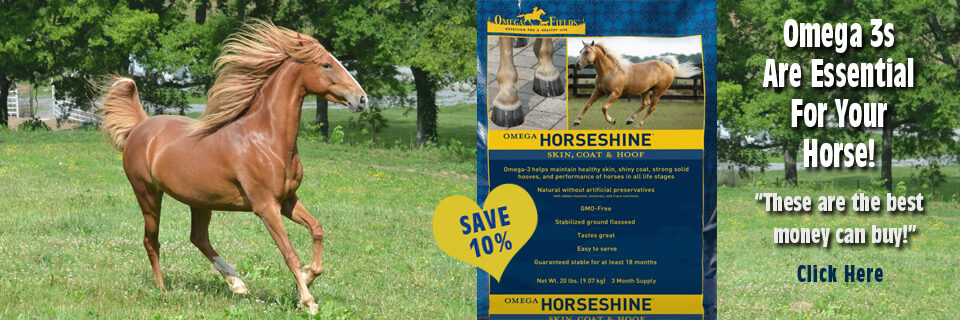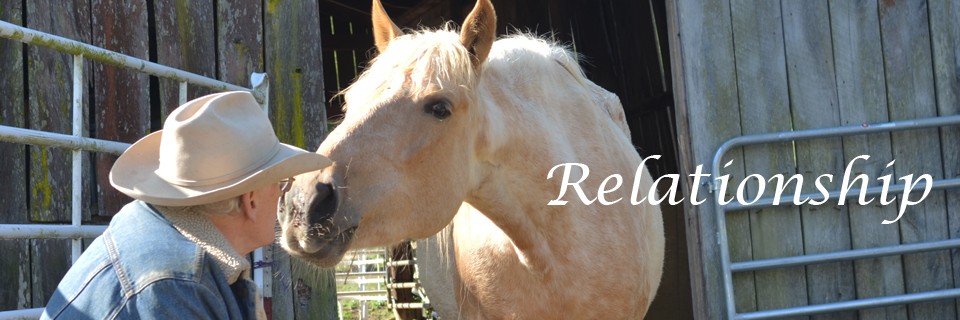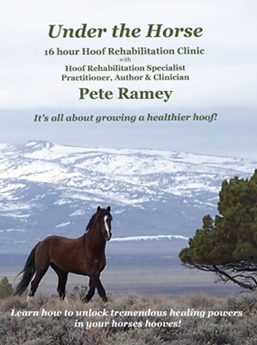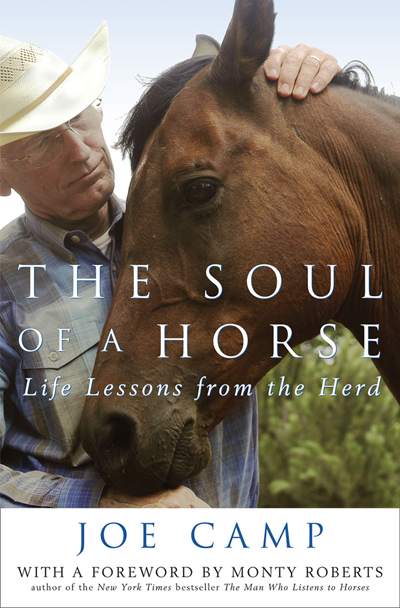



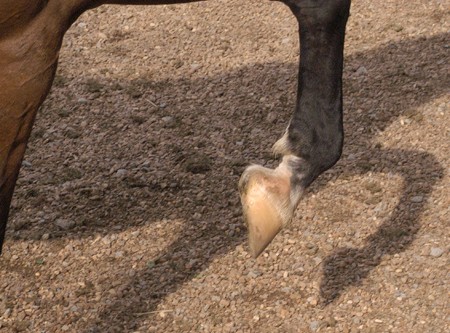

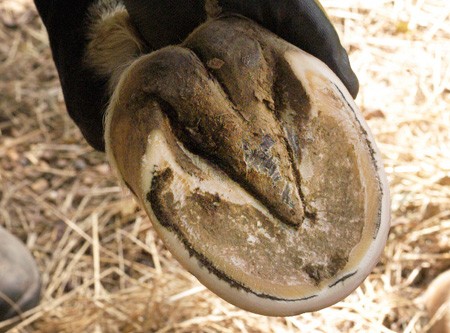




Not so many years ago I thought all horses had to have shoes. Everybody said so and I didn’t question. Until I started reading and stumbled upon an article in Horse & Rider. The first couple of paragraphs went something like this:
Did you know that a horse’s hoof is supposed to flex with every step taken? And that simple act of flexing is just about the most important thing a horse can do for good health and long life? The flexing provides shock absorption for the joints, tendons and ligaments in the leg and shoulder; acts as a circulatory pump for hundreds of blood vessels in the hoof mechanism; and helps the heart get that blood flowing back up the leg.
Without flexing, the hoof mechanism will not have good circulation and will not be healthy. And the heart will have to work harder to get the blood back up the legs. Without flexing, there will be no shock absorption.
And with a metal shoe nailed to the hoof, no flexing can occur.
Kerwhap! I was slapped right in the face with a piece of indisputable logic.
How insensitive to my inertia.
Four years later I discovered the thermograph displayed below which actually shows – in a real-life horse – what happens to circulation when a metal shoe is nailed on. This horse is wearing one metal shoe, on his front right. The other three hooves are barefoot. The thermograph is set to show blood circulation (or lack of it). He was walked around in a big circle and then the thermograph was taken.

The article in Horse & Rider went on to explore the results of Jaime Jackson’s study of more than one thousand wild mustang hooves. All barefoot hooves, of course. All very much alike, healthy and as hard as steel. The original Wild Horse Trim which now means to replicate the trim the horse would be giving itself if he or she were in the wild. Remember, the horse has survived for something like 52 million years, and being a flight animal, a prey animal, his feet are the most important part of that survival (Read an amazing article about Pete Ramey’s trip into wild horse country).
I was immediately off to websites, gathering books, soaking up information and knowledge. And one item I found puts to rest what so many were telling me: that the foot has been bred right off the horse, that the so called “domestic” horse no longer has the same foot as the horse in the wild. Nothing could be further from the truth. Actual science tells us that it would take a minimum of 5000 years – probably closer to 10,000 – to even begin to breed change into the base genetics of any species, including the horse. I also discovered a study confirming that every “domestic” horse today retains the ability to successfully return to the wild and be completely healthy. In other words, you do not really have a “domestic” horse. Genetically speaking, you have a wild horse in captivity. All horses on this earth are genetically the same (see Chronology of the Horse’s Evolution)
“If all that’s true, why does my horse appear to feel better with shoes on his feet?” I was asked recently.
Have you ever crossed your legs for such a long time that your foot goes to sleep? It’s because you have cut off the blood circulation to your foot. Essentially that’s what’s happening when a metal shoe is nailed onto a horses foot. The hoof no longer flexes. Which means a substantial loss of blood circulation in the hoof. Which mean the nerve endings go to sleep. And the ill health the hoof is suffering from lack of circulation is no longer felt by the horse. In other words, the “ouch” never reaches the brain.
That’s also why some horses are tender for a time after shoes are taken off. The hoof that has been unhealthy because of shoes now has blood circulation once again, and he can feel. Two of our horses were good to go right from the first minute the shoes came off. Two took a month or so, one about three months, and one took almost eight months. But all are happy campers now, with rock solid feet, on the trail, in the arena, on concrete and asphalt, wherever (See our hoof photos above).
It takes approximately eight months for most horses to grow a brand new hoof, from hairline to the ground. So with proper and consistent trimming, that’s should be the maximum time to have terrific feet unless there are serious lameness issues, imbalances, or the like, in which case it could take longer. But most of the time, during the transition, the use of hoof boots allows the horse to be ridden with no pain while still allowing the hoof to flex and and heal and grow as it was intended. Our gelding who took eight months to grow a whole new hoof was fine on the trail and the street with boots during his transition. He’s now fine without them.
No matter what you’ve heard to the contrary, the horse living in the Ice Age, the present-day wild horse, and the high-performance domestic breeds of today are all anatomically, physiologically, and psychologically alike. They all share the same biological requirements for health, long life, and soundness. In other words, we could not only be making the horse’s life as good as it is in the wild, we could be making it better. At least as healthy. And happier!
This addresses the concerns of some who are worried that the domestic horse has had his true genetics bred out of him. A few generations of selective breeding simply cannot erase the genteics of fifty-two million years. I have found no scientific or medical authority who even considers the possibility. The genetics are there and will take over, given the opportunity and the proper lifestyle, diet, and trim for recovery. Folks like Pete Ramey, Eddie Drabek, Jaime Jackson, James and Yvonne Welz, Mark Taylor and others, are proving this every day. They are saving horses who are at the end of their rope by pulling the shoes and easing into the Wild Horse Trim. Letting the horse grow the healthy, rock solid, hooves that nature intended them to have all along.
The entire Houston Mounted Police Patrol is now all barefoot with the wild horse trim. All 40 horses! Varied breeds and backgrounds. Thriving. Healthier than ever. And working on concrete, asphalt and marble all day every day! That pretty well shoots holes in the theory that all horses cannot go barefoot. All of theirs did. Read more.
Emile Carre, a past president of the American Farriers Association was quoted as saying “The (horse’s) foot was designed to be unshod, Anything that you add to the foot, like a horseshoe that is nailed on, is going to interfere with the foot’s natural process. Most horseshoes have six to eight nails, possibly one to three clips, all of which constrict the foot’s ability to expand and contract. Add pads, packing, any number of alternatives to the shoe, and you create a gait alteration. It all interferes with the natural process of the mechanism.“
Walt Taylor, also of the American Farriers Association, was quoted in an article in the American Farriers Journal (November, 2000) saying that 90% of the domestic horses in the world (that’s 122 million horses) have some degree of lameness and are still being used.
So the nailed-on metal shoe, in effect, becomes camouflage for what is actually happening within the hoof mechanism. The lack of circulation which dampens the feelings in the nerve endings hides the illness and pain the horse is actually experiencing.
Horses in the wild do not have hoof lameness issues. Dr. Jay Kirkpatrick (who has studied wild horses most of his adult life) says that virtually every case of lameness he’s seen in the wild is related to arthritic shoulder joints, not hoof problems.
Natural Hoof Specialist Eddie Drabek says, “I’ve had horses brought to me from owners who swore their horses had feet that grow abnormally, had bad genetics, could never be barefoot, have brittle hooves, heels grow but toes don’t, toes grow but heels don’t, have cracks that will never go away, and so forth… (I’ve heard it all)….but I’ve never met the horse who can’t be taken successfully barefoot with the proper wild horse trim and diet, and have beautiful feet to show for it. And I’m talking hundreds. I simply wouldn’t have dropped everything and changed my entire career if I wasn’t amazed with the results I was having. I was just at a horse show this past weekend watching many of my clients’ horses compete. Not a little po-dunk show, rather a big time show with competitors from as far away as Canada and Australia. By popular belief about their high performance bloodlines and their ‘genetically bad hooves’, these horses should not be able to be barefoot, but they all are (most for 3 years now), competing right up there with the shod horses, and they have better feet than ever before.”
National Championships in virtually every discipline have been won by barefoot horses. Barrels, cutting, jumping, racing, etc.
Arizona veterinarian Dr. Tomas Teskey says,”One of the greatest damages that occurs because of the application of steel shoes to the horse’s hoof is the greatly reduced circulation within the hoof, and the diminished return of blood back up toward the heart through the veins of the lower leg. Shoes interfere with the hoof’s natural blood-pumping mechanism. The natural hoof expands and contracts with each step, letting blood in as it spreads upon impact with the ground, and squeezing blood up and out of the hoof as it contracts when it is not bearing weight. If this sounds familiar, like the blood pumping mechanism of a heart, that’s because it is–natural hooves perform a critical function as supplementary “hearts”. This vital heart-like mechanism is greatly restricted by immobilizing the hoof with steel shoes.”
Convince yourself. Try this test. On a cool day, or under cover, feel the hoof and lower leg of a shod horse, and another that is barefoot. The barefoot horse’s lower leg and hoof will feel warm to the touch, because of the blood circulating within. The shod horse’s lower leg and hoof will be cool, not warm, because of the blood that is not circulating within. Or simply study the thermograph above.
Hopefully all this will stimulate you to study more and discover how you can enhance your horse’s health in a big way! Our bottom line is that, even though we lived at the top of a big hill with three turnouts that are heavily sloped and rocky, we (slowly, cautiously, and with abundant knowledge) took all six of our horses barefoot with the Wild Horse Trim, and they were then all as happy as clams, healthy as, well, a horse, and did fantastic… and now our eight continue to be happy and healthy in their new steep, hilly home in middle Tennessee (see our new place and our old place).
But… please don’t take our word for all this. Do the research yourself. Start with the many links below, and then branch out on your own. There is an enormous amount of solid research out there. Gobble it up. Then, don’t let others who have not done the research dissuade you. Someone once said that all truth passes through three stages. First, it is ridiculed. Second, it is opposed violently. Third, it is accepted as self evident. Give your horse the gift of barefoot. Then stand back and watch him frolic.
See the video
WHY OUR HORSES ARE BAREFOOT
10 Questions Before Hiring a Trimmer
Watch the Video Below
How We Kept Six Barefoot Horses Moving and Eating Happily,
Healthily on an Acre and a Half of Rock and Dirt
Joe’s Comments
on Pete Ramey’s 10-DVD set
Under the Horse
“Pete Ramey is my hero! He is why all of our horses are barefoot and healthy. He is much of the reason for the existence of my first book The Soul of Horse. He cares so very much about the horse and proves it daily by how much time he spends researching the complex internal workings of the horse’s hoof and the myriad factors that affect its health. And substantiating that research on the horses in his care. In his DVD series, Under the Horse, Pete lays every bit of it out for us. You will understand how and why the hoof works like it does, why so many domestic horses have lameness issues when no horses in the wild of the American west do, and what can be done to create a hoof for your horse like the one he’d have if in the wild. Pete’s easy style is engaging, clear, even entertaining and all the more powerful because he was once a shoeing farrier. He will bring you to the understanding that every horse is different so no prescription can be generic. But he will give you the tools and insight to always know what your horse needs. If you’ve ever doubted the fact that horses do not need metal shoes and are in fact better off without them, please see this series. Pete will convince you otherwise. In my humble belief, whether or not you ever intend to trim your own horse’s feet, Under the Horse is one of the most valuable and user-friendly compilations of knowledge, research, and insight for improving the health and lifespan of your horse that exists on the planet.” Click on the cover above.
Joe Camp
Read One Good Reason to Go Bitless
Buy ’em – Try ’em
Save 10% by clicking this link
and using the coupon code JOECAMP10 at checkout
Read More
Download Flyer
Send a copy of your Omega Nibblers email purchase confirmation to
nancy@thesoulofahorse.com
and receive a free PDF copy of Training with Treats!
The story of our journey with horses (to date) is told in the two books that follow: the national best seller The Soul of a Horse – Life Lessons from the Herd and its sequel Born Wild – The Soul of a Horse.
And what a story it is as two novices without a clue stumble and bumble their way through the learning process so that hopefully you won’t have to. If you haven’t read both of these books already please do because with that reading, I believe, will come not just the knowledge of discovery but the passion and the excitement to cause you to commit to your journey with horses, to do for the horse without waiver so that your relationship and experience will be with loving, happy and healthy horses who are willing partners and who never stop trying for you. Horses like ours.
The highly acclaimed best selling sequel to the National Best Seller
The Soul of a Horse – Life Lessons from the Herd
#1 Amazon Best Seller
#1 Amazon “Hot New Releases”
Amazon & Kindle
B&N
Order Personally Inscribed Copies of Born Wild
Order Both The Soul of a Horse & Born Wild – Save 20%
Both Personally Inscribed
Please list the names for each inscription in the “instructions to Seller” field as you check out!
Read More About Born Wild
Read More About The Soul of a Horse
Watch The Soul of a Horse Trailer
Watch the Born Wild Trailer
But first read the National Best Seller that started it all:

















